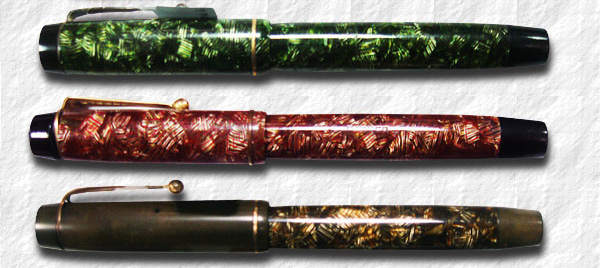
| parkerpens.net |
| PARKERCOLLECTOR.COM |
|
||
Parker had had a subsidiary in the UK since at least 1899, as shown by old ads. First there was only marketing and a selling force. Later the Parker UK subsidiary was assembling Parker parts made in Toronto, Canada. Parker had bought the Toronto factory in 1923 and soon 60% of it's production was being shipped to Europe. The setup worked fine, until World War II, when shipping became increasingly more risky. |
Some sources indicate that Parker already from time to time had had a co-operation with the Valentine Pen Company, in Newhaven, starting in the late 1930's.
According to David Shepherd in his book Parker Duofold, Valentine in 1932 even had to publicly apologise to the UK pen maker Conway Stewart for a patent infringement, albeit an unintended one. |
|
 Images © Tony Fischier courtesy of The Parker Archives |
Three beautiful Parker Victory, MK I, ca 1941. Note the cap on the bottom pen. |
 |
XXX |
There were also some Duofold Seniors produced with a Victory/Valentine style single, thin cap band. Furthermore the material shortages led Parker/Valentine to ship pens with different coloured bodies and caps, but the demand was so high that they sold regardlessly. From 1945 and on the text "MADE IN ENGLAND" was added to the imprints.
|
|
|
XXX |
MK V (1953- mid 1960's) 132 mm. The complete Parker UK line was revamped in 1953 when the new aerometric filling system, developed for the fabulous Parker "51", was fitted to the whole line of Duofold pens in the UK. There were several models available. The Victory now became identical in all aspects, save the imprint, with the Student. The two cap rings were removed in favour of a thin cap band engraved with chevrons. The colour grey was discontinued but the MK V was also manufactured in Denmark well into the 1960's. adding the colour Terracotta and possibly Apple green. |
The Victories are naturally very collectible. Especially the early pens from the 1940's in vibrant and uncommon colours. These have especially attracted the eye of the collectors of the early Duofolds, being a sort of extension of the model. The Victories sold in vast numbers, so the rarity can be debated, but they are of course much harder to come by in the US, since they were made for the European market.
|
|
XXX |
© 1995-2019 Tony Fischier and The Parker Pen Company®/Sanford Ecriture.
This page is in no way sponsored by or created by the Parker Pen Company®. All opinions, views, and thoughts expressed herein are expressly the authors, and in no way reflect the opinions, views, or thoughts of the Parker Pen Company®/Sanford Ecriture. All logos and/or images on these pages are © Copyright of Parker Pen Company®Sanford Ecritureunless otherwise stated and is reprinted by kind permission. If You feel that Your copyright has been violated please contact the WEBMASTER.
Everything on this website is copyrighted by law and can not be used without written permission from the author, Tony Fischier. You may however use the information as reference material and although it is forbidden to make digital copies or reproductions it may be physically printed for personal use, which does not include use on other web pages or in advertising. You may however quote parts of the content of this website, digitally or physically, providing that the source and author is clearly stated, together with the copyright information. In the US referred to as Fair use. If you use any information on this site, add a link.
Feel free to donate a small sum through Paypal to help this site to stay online. Acknowledgements.
Parkercollector.com in translated versions

